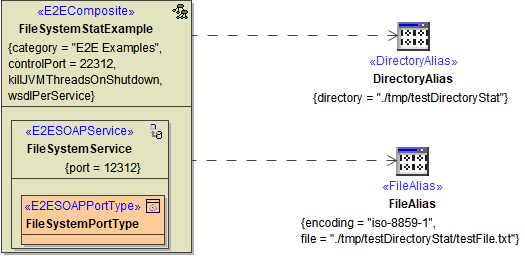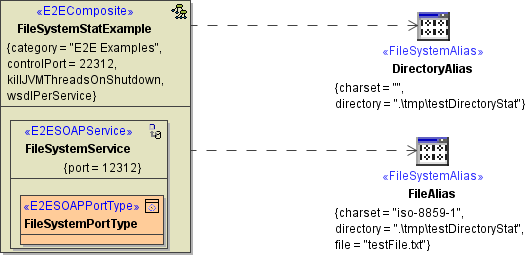Builder 7 The usage of file system access is represented by two aliases: a directory alias (having stereotype <<DirectoryAlias>>) and a file alias (having stereotype <<FileAlias>>). They are connected to the service composite by a dependency.
Figure: File System Component Diagram

The alias FileAlias represents a certain file, the alias DirectoryAlias represents a certain directory on the file system. On both you can use relative paths - they will be relative to the service directory on the E2E Bridge, then.
The directory alias can define a base directory and a default file encoding:
-
The default file encoding can be overridden per adapter call using a dynamic encoding parameter, e.g. on File System Adapter calls reading lines, or with the Flat File Adapter.
-
Regarding the base directory, the file name parameter will be treated as a path relative to this directory on the File System Adapter call. Jumping out of the base directory by
../../aDirectorytricks is impossible. The base directory can be changed in the service settings on the E2E Bridge, however.
See also Directory Alias and Dynamic File Access for an example of using the directory alias with dynamic file access.
Using a file resource, neither file encoding nor file path can be overridden.
Tagged Values
<<DirectoryAlias>>
Tagged ValueDescriptionAllowed ValuesdirectorySpecify a path to a directory. This directory will be treated as a base directory. It will be either used directly (for a File System Adapter operating directly on directories), or as a base directory for a path segment given by a dynamic file name parameter. It is not possible to jump out of the base directory by ../../aDirectory tricks. The base directory can only be changed in the service settings on the Bridge.Example:./tmp/testDirectoryfileEncodingSpecify the default encoding be used with the directory. This default encoding can be overwritten on adapter calls, using a dynamic encoding parameter, e.g. on File System Adapter calls reading lines, or with the Flat File Adapter.Refer to (25.3) Charset Definitions for possible values.defaultiso-8859-1
<<FileAlias>>
Tagged ValueDescriptionAllowed ValuesfileSpecify name and path of the file you want to access.Example:.tmp/testDirectory/testFile.txtencodingSpecify the encoding of the file.Refer to (25.3) Charset Definitions for possible values.defaultiso-8859-1resourceInstead of a file, you can select a resource from the list of imported resources. The File System Adapter will then use the resource instead of file.The resource can be replaced changing the resource path in the File System Adapter settings of the xUML service.If resource is specified neither file nor encoding can be overridden dynamically.See (25.3) Importing File Resources for more information on importing resources and (25.3) xUML Service Settings for more information on changing the settings of a service.
File System Components of Builder Version 6
Deprecated since Builder 7

